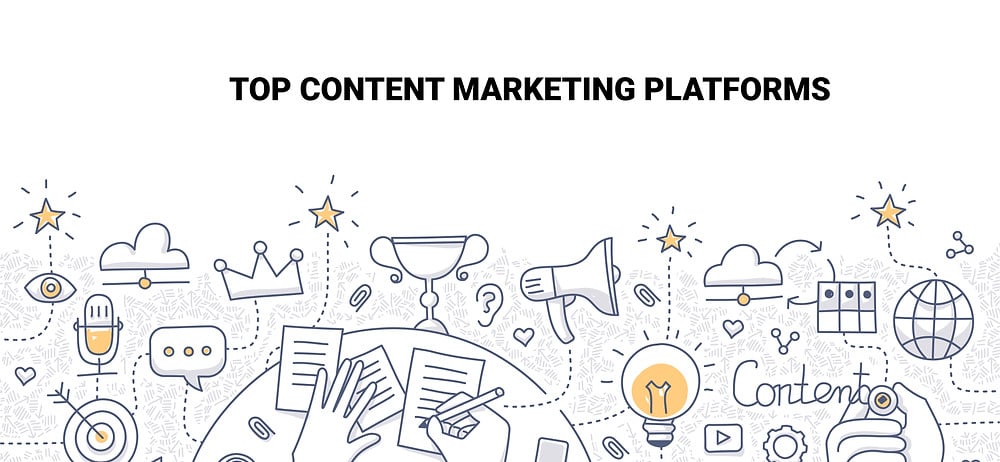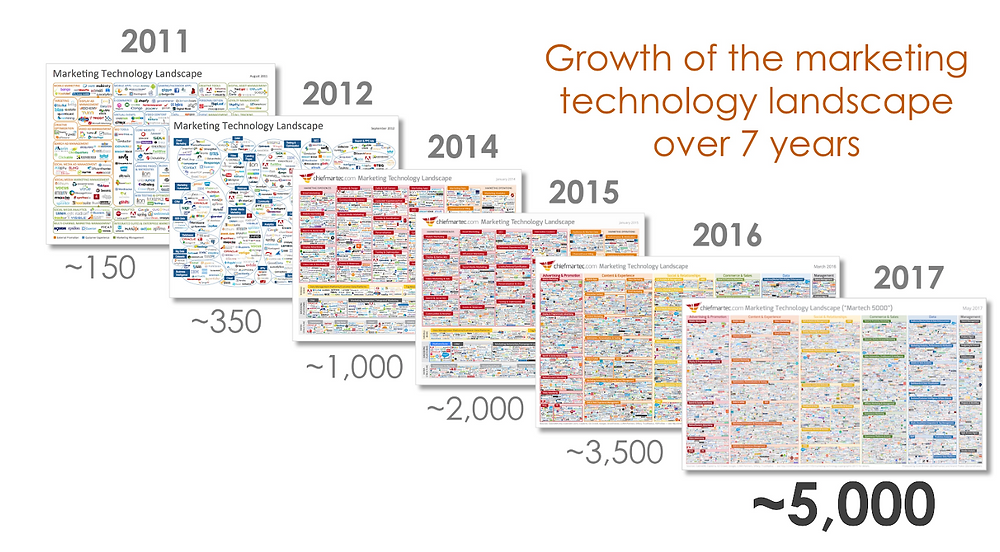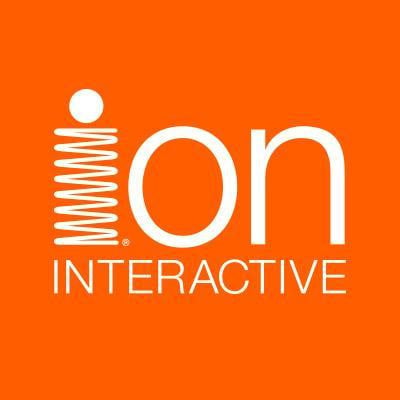
What does content marketing success really look like? On and off the Internet, we’re used to seeing big-name brands dish out tons of incredible content. But most have deep pockets, and that means more resources for more quality content. What about the smaller guys?
99.7% of all U.S. employer firms are small businesses (SMBs). That’s... a lot. And like their bigger brothers, SMBs can also double-down on content marketing without sacrificing quality. How? By finding creative ways to work smarter with content marketing platforms.
There’s no shortage of CMPs out there; they’ve been dominating the martech landscape since 2011 (as shown by Scott Brinker’s supergraphics below).

So. Many. Choices.
Of course, the choice is always yours. But if you’re a small business, choosing the right CMP can make or break your brand. Fortunately, we’ve sifted through the Internet and narrowed down the top 5 content marketing platforms available on the market today. Let’s get into it.
Content marketing platform: a quick definition
A content marketing platform is a comprehensive software solution that helps marketers maximize the value of every piece of content they create. Businesses can centralize and manage all marketing processes while generating leads, driving brand awareness, and launching structured marketing campaigns from one platform.
CMPs provide data-driven marketing insights to help businesses create better brand stories as well. Curata, a popular content curation and marketing platform, says they “enable a multi-channel approach across four process areas: strategy, production, distribution (publication and promotion) and analytics."
Get the full scoop on content marketing platforms here.
The 5 best content marketing platforms for small businesses (in no particular order)
1. Joomag

Lauded as the all-in-one publishing platform, Joomag delivers industry-leading content marketing, sales, corporate communications, and digital publishing software solutions. That’s a tall order, and Joomag handles it exceptionally well by providing businesses with everything they need to create digital magazines, brochures, catalogs, eBooks, reports, corporate materials, and other marketing collateral. Engage readers with interactive elements and make the most out of fully integrated creation, distribution, tracking, and monetization tools. Founded in 2009, Joomag’s popularity has surged in recent years. The platform has garnered numerous accolades and expanded into international markets.
2. Uberflip

Uberflip is a cloud-based content marketing platform. Businesses can “create, manage, and optimize content experiences at every stage of the buyer's journey.” The platform offers automated content curation and publishing tools tailorable to various buyer personas. Uberflip amalgamates the content experience by curating content from around the Web and presenting it in a central hub. It’s a handy tool for marketers looking to manage their blog posts, eBooks, white papers, and other marketing assets. Businesses can measure the impact of their marketing initiatives with Uberflip’s built-in content performance metrics.
3. Ion interactive

ion interactive is a digital content platform that “creates data-driven experiences without tech-savvy resources or developer code.” Its Easy Quick Starts Cloud features prefabricated infographics, white papers, quizzes, eBooks, and product tours. Entire content assets can be launched in under an hour without any prior training or skill. The platform’s suite of interactive creation tools includes 20 animations, transitions, scroll triggers & effects, videos, and responsive design controls. ion also sports actionable analytics, A/B/n testing functionality, and CRM access.
4. Ceros

Ceros, like Uberflip, is a cloud-based CMP that empowers marketers and designers to build engaging online content without any coding. Companies can leverage its collaborative software to design and publish content that works across multiple devices with ease. Ceros’ freeform canvas allows users to drag and drop assets and fully visualize template designs. All assets are embeddable and can live anywhere on the Web. The platform’s analytics dashboard tracks content performance on a granular level while sporting integrable eCommerce features.
5. Curata

Curata is a hybrid content marketing and curation platform. Its Content Curation Software (CCS) offers a wide selection of published content and is, as described on the company’s website, “the fastest way to find and share content gold.” Curata CCS uses keywords and other search criteria to scour the Web for relevant results. Its learning engine adapts to user behavior patterns and improves results based on shared content and ratings. Curata's content marketing platform (Curata CMP) includes analytics, editorial calendaring software, workflow templates, and seamless integration to help SMBs optimize their content supply chains.
With the abstracts out of the way, let’s dive deeper into the features each platform offers.
For interactive content creation:
1. Joomag:
An all-in-one publishing platform that empowers its users with choice. Create interactive content from scratch, uploaded PDF files, or from over 300 templates. Joomag’s flagship Crater™ Editor gives businesses complete creative control over their content. Make digital magazines, catalogs, brochures, newsletters, presentations, portfolios, eBooks, newspapers, menus, documents, photo albums, and user manuals. Enrich static assets with interactive elements, including videos, photos, slideshows, music files, plugins (Rating, Feedback Form, Shoutbox, Email Subscribe, and Call Me Back), hotspots, shapes, drawings, and more.
2. Uberflip:
Create 2 types of CTAs to increase conversions, transform PDFs into flip books, gather assets into a centralized Content Hub, and build collections of content for targeted prospects.
3. ion interactive:
Create customized interactive experiences, including infographics, calculators, quizzes, white papers, landing pages, lookbooks, resource libraries, solution finders, eBooks, ratings, and product tours from templates or from scratch. The ion platform includes custom branded themes, “20 animations, 5 triggers, interactive video & video backgrounds, app-like transitions, scroll triggers & effects, flows, rotators, reveals, and responsive design controls.” (Source)
4. Ceros
Users can create and design their very own infographics, menu bars, eBooks, lookbooks, carousels, banners, landing pages, presentations, slideshows, and microsites by dragging and dropping interactive assets (images, video, animations, fonts, widgets, simple triggers and actions, hotspots, contact forms) to the Ceros Studio. Features hundreds of templates as starting points.
5. Curata
Primarily a content curation platform, Curata’s self-learning engine delivers relevant content from thousands of sources to one location. Users can specify which types of content they want while also authoring and publishing original content within the platform. Curated assets can be enriched with insightful metadata, including royalty-free pictures, videos, and quotes. Businesses can save time with content templates as well.
For lead generation:
1. Joomag: add lead generation forms, interactive pop-ups, and email signup forms directly to your content. Businesses can also embed subscription form codes to their websites and generate leads from them.
2. Uberflip: CTAs in Content Hubs can connect directly to marketing automation platforms. Customize each call-to-action (design, fields, location, etc.) to ensure your brand messages and values align. Sync Uberflip with various MAPs and send leads collected in Content Hubs to external databases.
3. ion interactive: drive qualified leads with interactive calculators, infographics, assessments, landing pages, and quizzes. ion’s integrated A/B/n testing software obtains and documents lead data to help marketers improve their program outcomes.
4. Ceros: supports both “in-Experience lead generation tactics and lead generation tactics that require a click out to a separate page.” (Source). CTA buttons can redirect visitors to external landing pages, websites, or pop-up lead gen forms. Pop-up forms can be configured to appear when certain viewing conditions are met. Ceros also features display retargeting, social retargeting, and trigger sales outreach for post-viewing lead generation.
5. Curata: does not have specific lead generation tools, though curated content is often used to help drive traffic and generate leads.
For branding:
1. Joomag: customize Joomag’s magazine viewer to fit your brand’s unique look and feel. Include logos in the viewer, change its background color, and upload custom themes. Brand email templates with colors, texts, images, and embeddable links while adding logos to checkout pages for a more personalized approach. Users can even order custom branded iOS and Android apps for their publications.
2. Uberflip: onBrand is Uberflip’s internal development team. It works closely with customers to ensure their Content Hubs are consistent with their brands’ overall image.
3. ion interactive: ion codes one branded theme per customer which can then be applied to his or her ion experience. Brand-approved styling includes custom fonts, buttons, and colors. Logos can also appear in the top-left corner of the page. With micro-themes, marketers can create hundreds of on-brand page style combinations from one theme that’s based off their domain’s unique guidelines.
4. Ceros: supports custom branded (uploaded) fonts and branded favicons. Favicons will appear on a published Ceros Experience after uploading a short line of code.
5. Curata: lacks branding tools and white-labeling options.
For distribution:
1. Joomag: deploy content through social media (Facebook, LinkedIn, Twitter, Google +, Pinterest, Blogger, Tumblr, Stumbleupon, Reddit ), print, custom domains, embedding, email, shortened URLs, and Joomag’s very own newsstand.
2. Uberflip: Content Hubs are Uberflip’s primary distribution channel, allowing marketers to pull different types of content into one location. Moreover, uploaded PDF files are automatically converted to HTML5 for mobile and desktop devices. Users can also distribute URLs through email and social media.
3. ion interactive: interactive content can live on landing pages, microsites, or on any other web pages (homepages, product pages, social media).
4. Ceros: unfortunately, Ceros users cannot share entire pieces of content on social media or in emails.
5. Curata: share industry-specific content to blogs, social channels, newsletters, integrated marketing automation platforms, content management systems, mobile apps, hosted microsites, widgets, and Curata’s built-in website and blog.
For SEO:
1. Joomag: features a built-in SEO tool that obviates third-party software integrations. Improve content visibility on search engines by selecting specific keywords, phrases, and text while adding unique metadata, tags, and descriptions.
2. Uberflip: users can optimize items in their Content Hubs with canonical URLs, auto redirecting to an item’s canonical URL, SEO titles, and SEO descriptions.
3. ion interactive: robot controls, canonical URLs, SEO-specific content via SEO paths, query string controls, automatically generated Robots.txt files, 301 redirects, automatic sitemaps, SEO-friendly URLs, and the ability to ping search engines.
4. Ceros: a Settings Panel allows users to add information that helps search engines index content more easily. The Experience Settings tab contains four sections: “Experience Settings,” “SEO Properties,” “Social Sharing,” and “Custom HTML.” Under “SEO Properties,” users can define title keywords, canonical URLs, meta descriptions, and NoScript HTML tags.
5. Curata: enabling Curata’s provided microsite gives businesses more leeway for SEO, like adding keywords, meta tags, and homepage & blog meta descriptions. Alternatively, opting not to use the microsite lets businesses connect Curata to their content management systems instead (binding metadata between the two in the process).
For analytics:
1. Joomag: includes Daily Views, Sessions, Daily Readers, Views, Unique Views, Pageviews, Unique Pageviews, Pages / Session, Avg. Session Duration, Reader Country/Territory, Sessions, % Sessions, Traffic Sources (Referral Traffic, Search Traffic, Direct Traffic, Campaigns, QR Scans, Embeds), Search Engine, Mobile Devices, Downloads, and Links.
2. Uberflip: Unique Visitors, Visits, Avg. Time / Visit, Unique Page Views, Page Views, Flipbook Views, Pages / Visit, CTA Impressions, CTA Conversions, Zooms, Link Clicks, Page Widget Interactions, Pages Printed, Search Queries, Pages Downloaded, Flipbooks Downloaded, Bookmarks Added, Bookmarks Deleted, Notes Added, Notes Modified, Notes Deleted, Clippings Added to Basket, Clippings Emailed, Clippings Printed, Clippings Removed From Basket, Crops Printed, Crops Saved, Text Mode Page Views, and Social Shares. Clicking on a metric reveals its associated report, which in turn details each metric’s value.
3. ion interactive: the ion console includes performance gauges for recent portfolios, campaigns, creatives, and traffic sources. Because they’re so extensive, ion has created two support videos detailing its metrics:
4. Ceros: Visitors (Average Visitors Per Day, Total Visitors, Visitors By Device, Visitors By Device Type, Visitors By Browser, Visitors By Country), Opens (Opens By Day, Total Opens, Average Opens Per Day), Page Views (Page Views By Day, Total Page Views, Average Page Views Per Day, Page Views By Page), Visitors by Page (Total Visitors, Average Visitors Per Day, Visitors By Page), Inbound Referrals (Referring Domains, Referring URLs), and Engagement KPIs (Total Time Spent for All Visitors, Average Time Spent By a Visitor, Average Time Spent on a Page, Total Shares,Total Interaction Clicks, Total Video Plays, % of Visitors Shared Socially, % of Visitors Clicked an Action, % of Visitors Played a Video, Total Outbound Link Clicks, % of Visitors Clicked and Outbound Links).
5. Curata: Curata CCS features analytics for email newsletters and basic metrics for connected sharing channels like Twitter (Social Shares, Page Views, Unique Views, Leads Generated, Leads Touched, Pipeline Generated, Pipeline Touched, and Revenue Influenced).
For integrations:
1. Joomag: integrates with Zapier, Salesforce, HubSpot CRM, Insightly, Intercom, Pardot, Marketo, MailChimp, Constant Contact, Campaign Monitor, Dropbox, Box, Google, Drive, and AdRoll.
2. Uberflip: Marketo, Pardot, Eloqua, HubSpot, Google Analytics & Tag Manager, Google Search Console, Bombora, AddThis, Disqus, Act-On, MailChimp, BrightInfo, and Optimizely.
3. ion interactive: is integrable with Oracle Eloqua, Marketo, Salesforce, Demandbase, Act-On, Aprimo, AWeber, Campus Management, Clicktale, Crazy Egg, dotmailer, DoubleClick, Google, HubSpot, Infusionsoft, MailChimp, Mongoose Metrics, Net-Results, Omniture, Siebel, SugarCRM, Talisma, Uberflip, YouTube, Vimeo, Ooyala, Brightcove, HTML5, Facebook, LinkedIn, Google +, and Pinterest.
4. Ceros: unfortunately, Ceros does not integrate with email service providers. It can, however, sync with content management systems, eCommerce platforms, (Magento, Demandware), analytics programs (Google Analytics, Omniture, Google Tag Manager, Mixpanel), and marketing automation platforms (HubSpot, Marketo).
5. Curata: Marketo, MailChimp, HubSpot, Eloqua, Salesforce, Buffer, Flipboard, Pardot, Google Analytics, WordPress, Joomla, Act-on, Drupal, Moveable Type, TextpatternFacebook, LinkedIn, Twitter, and Pinterest.
For email marketing:
1. Joomag: packaged with comprehensive email marketing software. Pick a predesigned template and fill it with content (text, images, colors, borders, buttons, social media links, publications) that resonates with your brand. Then launch an email campaign by selecting a template and choosing contacts you wish to send it to. Features extensive email campaign metrics to boot: Delivered %, Delivering %, Dropped %, Bounced %, Click %, Open %, Unsubscribe %, and Complaints.
2. Uberflip: Uberflip lacks a built-in email marketing system.
3. ion interactive: with email templates, users can send fulfillment emails to respondents at different stages within a path (commonly used as post-conversion delivery vehicles for offered content assets). Moreover, formatted emails can be used to deliver leads to specific addresses in real time.
4. Ceros: integrates with marketing automation tools.
5. Curata: send ad hoc emails to subscribers, or deliver automated email newsletters on a daily, weekly, or monthly basis.
For CRM:
1. Joomag: includes an integrated, highly flexible CRM solution for small businesses: the Awesome CRM™. Users can acquire and manage contacts, subscribers, and leads from a single interface. Export contacts, create them manually, select a XLS, XLSX, or CSV file to import lists, or integrate with other CRM systems and work with existing subscribers seamlessly. Marketers can segment contacts based on specific criteria and deliver personalized content to each of them. Features subscriber analytics as well (active subscriptions, purchases, and unsubscribe rates).
2. Uberflip: lacks a dedicated CRM tool.
3. ion interactive: does not feature built-in CRM software; users must integrate with other CRM services. Once an external CRM is synched, conditional logic can be implemented to export contacts to different platforms based on their qualifications.
4. Ceros: lacks a built-in CRM tool. Integration with third-party software is required.
5. Curata: does not have a built-in CRM system.
For pricing:
1. Joomag: features 3 core membership plans: Pro ($79 USD per month - billed annually), Business ($149 USD per month/user - billed annually), and Enterprise (pricing varies; for large scale businesses). Users can try Business free of charge for 14 days.
Joomag is also a popular choice for thousands of educational institutions worldwide. Accordingly, it offers 3 different EDU plans as well: EDU Class (free), EDU School ($495 USD per year), and EDU Campus ($4,950 USD per year).
2. Uberflip: annual subscription-based pricing model with no specific membership plans. Uberflip also does not offer a free trial for users.
3. ion interactive: features 3 scalable pricing plans: Bronze ($1,800 USD per month for 6 pieces of content - billed annually), Silver ($2,500 USD per month for 25 pieces of content - billed annually) and Gold ($3,700 USD per month for unlimited creatives - billed annually).
4. Ceros: businesses can try Ceros for 30 days as part of its paid pilot program ($3,000 USD, billed once) and then decide whether or not to continue with an annual subscription. If not, users keep all assets created during the pilot program. Final pricings are value-based.
5. Curata: features 4 plans: Intro (1 publishing channel), Basic (4 publishing channels), Advanced (9 publishing channels), and Enterprise (Custom - 10+ publishing channels). Pricing varies; customers will need to contact Curata for a custom quote.
Conclusion: And the winner is...
No one! A bit anticlimactic, we know, but the platform you choose will depend on your specific needs as a small business. But if you’re looking for an end-to-end solution built with your convenience in mind, then give Joomag a shot. We’re the CMP of choice for over 500,000 businesses worldwide, and for good reason. Joomag is complete in every sense of the word. Its fully integrated framework empowers marketing teams while creating a rich ecosystem for content to thrive. Earlier this year, G2 Crowd, the world’s leading B2B review platform, placed Joomag on its top 5 list of the best content marketing software of Winter 2018. Head on over there to see what customers are saying about us, or click here to learn more about our marketplace leader award. Enjoy!
Stop jumping back and forth between platforms.
Use one to keep your content marketing on track, all the time.
FAQ
1. What makes a content marketing platform (CMP) essential for small businesses?
A CMP offers a comprehensive solution for managing and enhancing all marketing processes, enabling small businesses to generate leads, drive brand awareness, and execute structured marketing campaigns efficiently. It centralizes content management and provides data-driven insights for creating compelling brand stories.
2. How can small businesses choose the right CMP?
Selecting the right CMP depends on the specific needs of a business, including the need for interactive content creation, lead generation, branding, distribution, SEO, analytics, integrations, email marketing, CRM, and pricing models. Assessing these features in potential platforms can guide small businesses to the right choice.
3. Are there affordable CMP options for small businesses with limited budgets?
Yes, there are CMPs tailored to various budget levels, offering scalable pricing plans and free trials to test their services. Platforms like Joomag, ion interactive, and Ceros provide different pricing tiers and free trials, making them accessible for small businesses to start with content marketing without a significant upfront investment.














